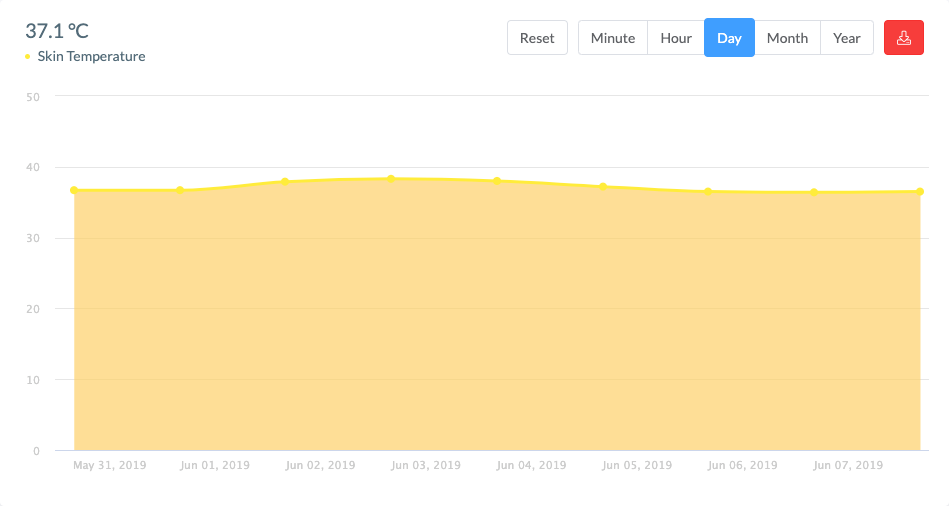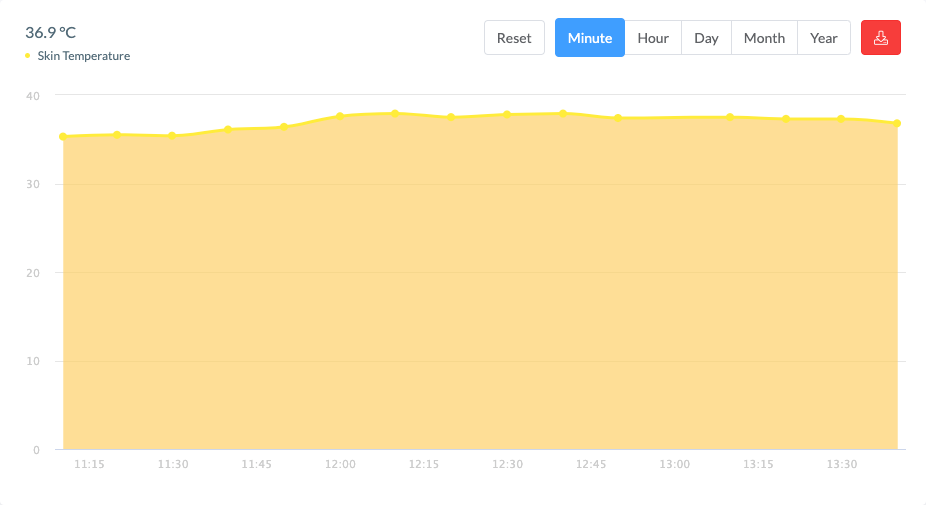Not many people realize that tracking long-term temperature is just as important as identifying if you’re unwell. Besides, confirming an illness, it can be used to track many things that occur in your body, such as the menstrual cycle or recovery time after a sickness.
Body temperature is probably the most popular indicator of one’s health. For instance, when you get sick, your elevated body temperature will be momentarily noticeable. When your skin starts feeling hot, you grab a thermometer, get a result and… that’s it. If it’s above 37.5°C (310K) you know you might be ill. Also, you might need to check it once again if you start feeling worse or after prevailing the sickness to confirm it’s over.
I think everyone will agree when I say that it’s quite hard to imagine yourself walking around with a thermometer under your armpit for the entire day. So, for continuous tracking, a comfortable method of taking measurements is highly appreciated. Now, there is one perfect method for measuring your temperature that doesn’t include taping the thermometer around your forehead. I am thinking of chest straps, allowing to monitor nocturnal and daily skin temperature constantly. Constantly tracking our temperature, allows us to identify deviations and trends, meaning that you can be notified when, for example, your period is due. It can also help you to recognize if you’ve caught an illness like tonsillitis, and its now devastating your immune system.
 The daily mean temperature was recorded when the subject was suffering with tonsillitis. Note that the increased skin temperature was between 1st to 5th of June.
The daily mean temperature was recorded when the subject was suffering with tonsillitis. Note that the increased skin temperature was between 1st to 5th of June.
Of course, skin temperature is a slightly different type of measurement because it’s affected by ambient temperature. It oscillates predictably with the time of day. Thus, a healthy temperature at any site is described by a range of values, rather than a fixed value. This is important because when the temperature is used to determine the relative health of an individual, a group mean will not necessarily accurately categorize an ideal temperature for all members of that group. Some healthy individuals would be expected to have values higher or lower than the mean and these values would, in theory, be normal for them. Your skin temperature varies parabolically from 83 deg F. (28.2 °C) at an ambient temperature of 49 deg F. (9.5 °C) to 98 deg F. (37.2 °C) at an ambient temperature of 95 deg F. (35 °C) [1].
It would take a heavy book to describe every possible use for temperature readings. So, we’re going to stick and focus on assessing menstruation and workouts.
In most cases, measurements should differ between the pre-ovulation phase and post-ovulation phase. Obviously, there are some possible variables, like hormonal birth control, which may suppress the monthly temperature variation or medication that influence the results. However, over time, you should be able to see a pattern, regardless of these variables. Realizing the fact that a woman is entering the next stage of the menstrual cycle is highly important, not only for pregnancy measures but also for sports. As female athletes should always remember that optimal strength training benefits will be achieved, when highest training loads are scheduled at pre-ovulatory period, and to avoid overloading during the latter half of the menstrual cycle will provide amazing results. Cyclists, runners, and all kinds of sportspeople, workers or even pensioners should be able to find analogical uses for their activities and lifestyle itself easily. One of the most important reasons for measuring skin temperature is to avoid heat stroke. Traditional heart disease can lead to a heart attack during a race, even in apparently healthy middle-aged runners, and many young runners train and race with undetected congenital heart conditions. The same goes with skin temperature. No matter what the temperature is outside, your skin temperature will increase over time with exercise.
 Skin temperature of a healthy person during the marathon. The ambient temperature was oscillating around 81 deg F. (27 °C).
Skin temperature of a healthy person during the marathon. The ambient temperature was oscillating around 81 deg F. (27 °C).
When you run hard — your body generates a large amount of heat, and if you can’t get rid of it effectively, this could result in a heat stroke. Concluding all of the information above, it evident that it is really helpful to have all the data about temperature trends or sudden changes. As this data can help in our everyday routine. Women are not the only ones affected by frequent changes and the menstrual cycle is just one simple example, which makes those cyclic changes more understandable.
[1] Dr. K.R. Koehler College Physics for Students of Biology and Chemistry, University of Cincinnati




